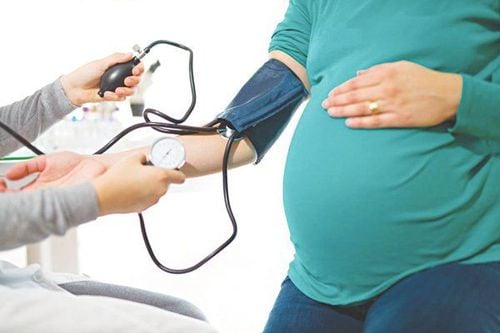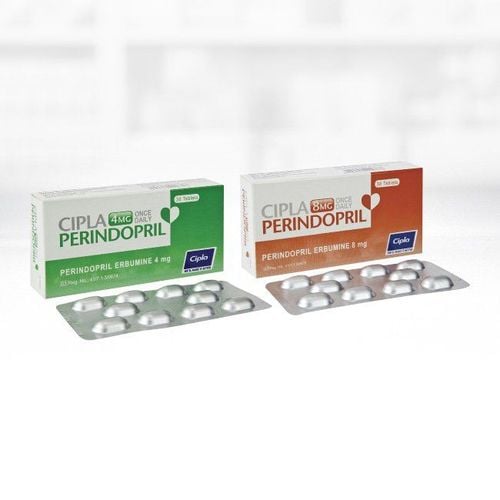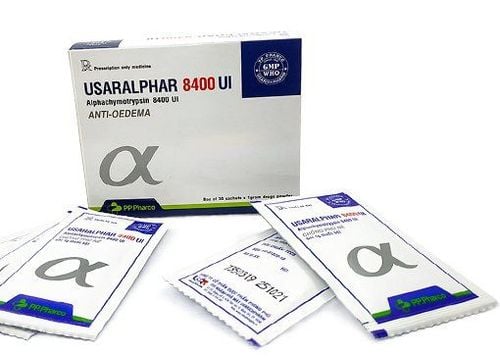This is an automatically translated article.
The article was professionally consulted by Specialist Doctor Obstetrician and Gynecologist - Department of Obstetrics and Gynecology - Vinmec Hai Phong International General Hospital. The doctor has many years of experience in the field of obstetrics and gynecology.
Preeclampsia is a systemic pregnancy syndrome and usually occurs during the third trimester of pregnancy. Preeclampsia is also the first stage of eclampsia and can cause a number of dangerous complications.
1. Manifestations of preeclampsia
Preeclampsia syndrome, also known as toxic pregnancy, is a dangerous disorder that occurs in pregnant women after the 20th week. The main symptoms of preeclampsia include high blood pressure. , increased protein in the urine...
Until now, the causes of preeclampsia are not clear. But an imbalance of prostaglandins in the body is thought to increase the risk of preeclampsia.
Symptoms of preeclampsia include increased blood pressure, increased proteinuria, edema,...
1.1 Hypertension
Pregnant women with systolic blood pressure greater than 30 mmHg or diastolic blood pressure 15 mmHg higher than pre-pregnancy blood pressure need special attention because these women are very susceptible to preeclampsia. Pregnant women with high blood pressure have a higher risk of preeclampsia.
A woman should also note that if her blood pressure is still high 6 weeks after giving birth, she needs to see a cardiologist immediately for timely treatment.

1.2. Proteinuria Elevated Proteinuria is the amount of protein in the urine, the higher the concentration, the higher the risk of preeclampsia. Proteinuria levels in 24 hours can vary quite a lot, so for the most accurate test, a pregnant woman's urine must be collected within 24 hours.
When tested, positive proteinuria is when the amount of protein in the urine is > 0.3g/l/24h or more than 0.5l/random urine sample.
1.3 Edema Edema is also one of the symptoms of preeclampsia, but it is important to distinguish physiological edema in pregnant women from pathological edema. In normal pregnant women, the background edema only occurs in the last 3 months and there is only slight swelling in the legs, usually in the afternoon and when lying down, raising the legs will go away.
Pathological edema or symptoms of preeclampsia is the phenomenon of generalized edema, swelling in the whole morning and raising the legs does not go away. If it is severe, the mother can also have polycystic edema or cerebral edema which is very dangerous.
Pathological edema can be detected by pressing on hard ground, usually you should check in places such as the instep of the foot, hand, anterior eye of the pelvis. Edema is often accompanied by manifestations such as rapid weight gain of the mother, about >500g/week or >2250g/month is considered rapid gain.
1.4 Some severe symptoms If not detected and treated promptly, pregnant women can develop more severe symptoms of preeclampsia such as anemia, fatigue, pale skin and pale mucous membranes bland. Gastrointestinal signs include nausea, epigastric pain, and right upper quadrant pain.
Neurological signs, pregnant women often have pain in the occipital region, lethargy, fatigue, and pain medication does not help. Women may also experience visual symptoms such as dizziness, lightheadedness, decreased vision, and sensitivity to light.

2. Dangerous complications of preeclampsia
2.1 For pregnant women Preeclampsia can leave dangerous complications for the pregnant mother's body. Complications on the mother include eclampsia, cerebral edema, retinal edema and possibly retinal blindness, cerebral hemorrhage... for the urinary system, acute renal failure, renal tubular necrosis and renal failure may result. preeclampsia. Pregnant women can also have severe anemia, low platelets in the blood, microvascular hemolytic anemia.
For the respiratory system, pregnant women with preeclampsia may have pulmonary edema, laryngeal edema. And most importantly, in terms of obstetrics, pregnant women can have placental abruption, placental abruption or premature birth if they have preeclampsia.
2.2 For the fetus The fetuses of mothers with pre-eclampsia often suffer complications such as fetal growth retardation, or neurological complications later, which are also very dangerous for the fetus. In addition, the fetus can also be born prematurely and have cardiovascular diseases later in life.
Complications, whether for the mother or the baby, are very dangerous and pregnant women always need to be monitored regularly to diagnose the risk of preeclampsia later on.
The best way to prevent this preeclampsia is to keep yourself in good health, stay away from stimulants or drugs or can harm the fetus. Besides, it is also necessary to regularly monitor the health of pregnant women to be able to understand the situation and diagnose if pre-eclampsia.
Above is information about preeclampsia and dangerous complications of preeclampsia. Take care of the health of the pregnant woman as well as the fetus in the most thoughtful way and periodically check the pregnant woman's health to detect pre-eclampsia as soon as possible!
Please dial HOTLINE for more information or register for an appointment HERE. Download MyVinmec app to make appointments faster and to manage your bookings easily.













